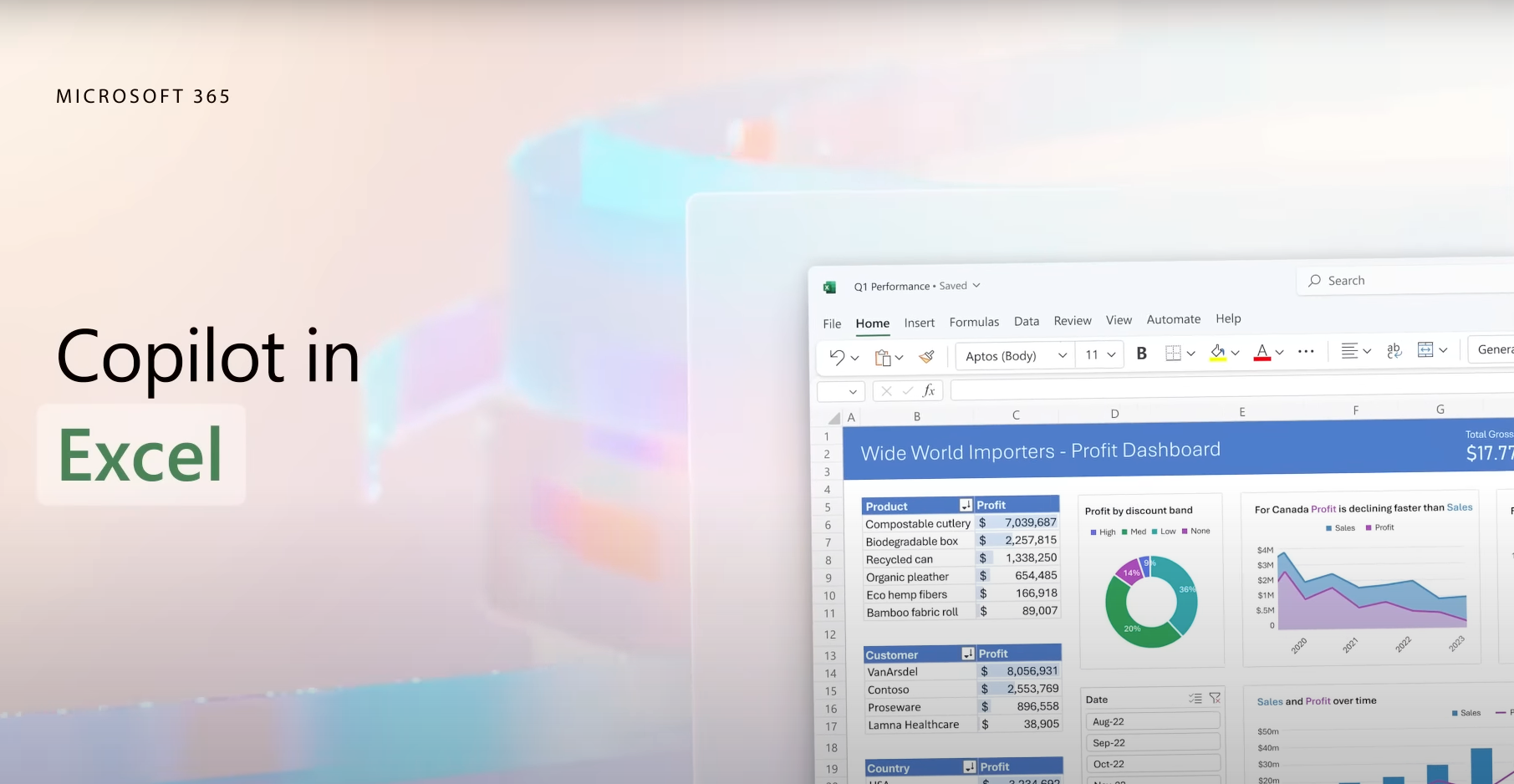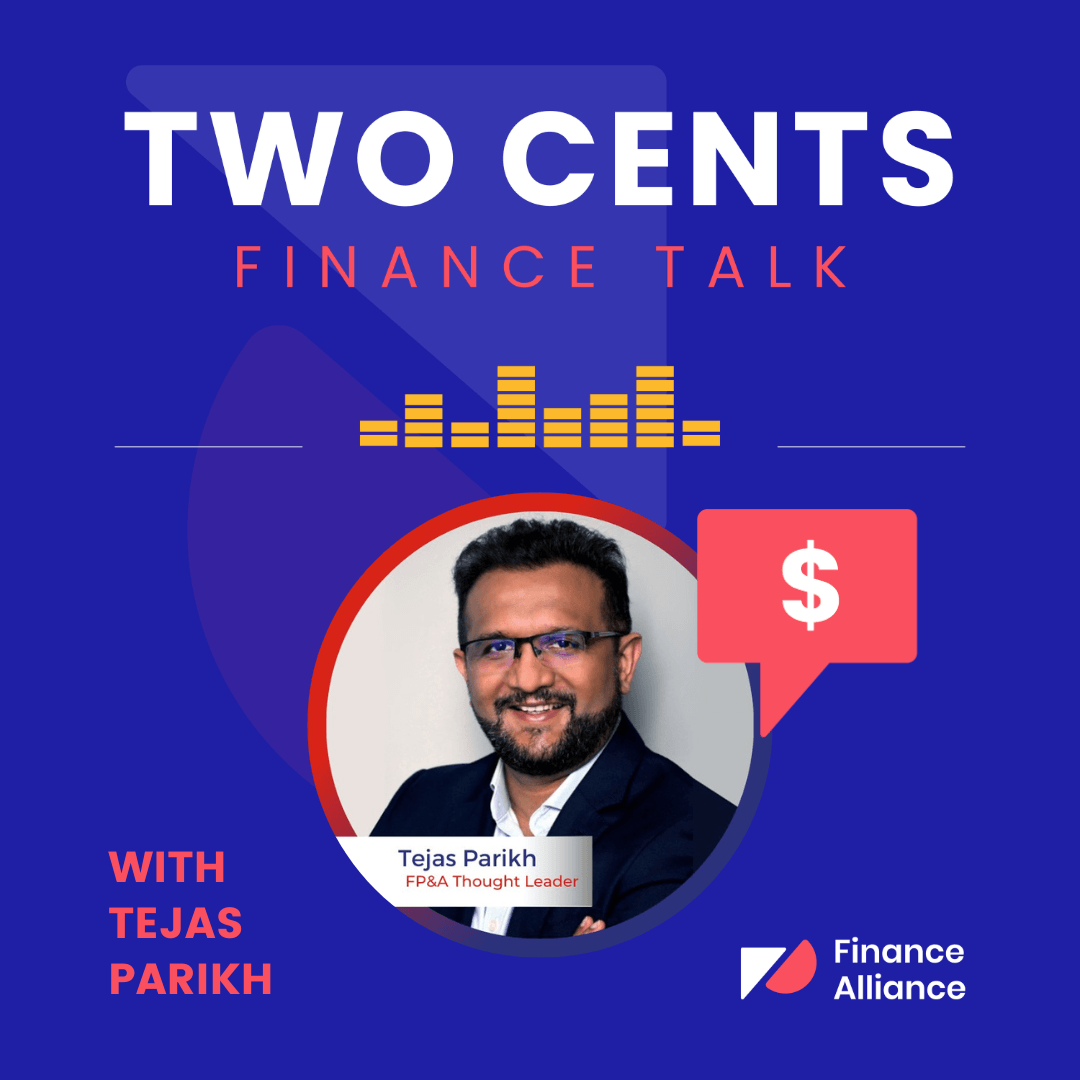The road to digitalization in finance is paved with many pitfalls and challenges, but thankfully, there are ways to make sure the journey is a smooth one.
In this episode of the Two Cents: Finance Talk podcast, you'll hear from Tejas Parikh, FP&A transformation specialist and Lead Consultant/Director at Akshar Business Consulting Ltd.
Tejas talks about why many finance professionals are stuck in the past and how you can implement digitalization in finance successfully within your organization.
Tejas spoke to us about:
- Why it’s time to move on from Microsoft Excel
- Why digitalization in finance is about changing the ways we work
- The importance of embracing technological change in finance
- Drive finance transformation from the top down, but deliver it from the bottom up
- Why the fear of change is preventing finance transformation
- The major pitfalls of digital transformation in finance
- How technology can improve work-life balance
- Top tips for successful digitalization in finance
Listen to Tejas' interview below, or keep reading the full blog version of this episode:
Why it’s time to move on from Microsoft Excel
For anybody who’s still working on Excel, you're stuck in the 1980s. It might be controversial, but people who know me know I never shy away from controversy, and I do like to make statements like this. Not to grab attention, but to stimulate thinking.
We’re finance professionals. And most finance professionals I've worked with are at least partly if not fully qualified charters. And with all their training and qualifications, they’re happy to continue to do things the way they’ve always been done. And I just think, You’re so well qualified, why are refraining from thinking differently? That’s wrong.
The whole idea of educating a population isn’t so they don’t think and don’t challenge themselves. That's not good.
So I tend to make controversial statements very respectfully from the perspective of getting people to think. Do I really need to be stuck in Excel? Is there a better way of doing these things? Maybe I should at least consider the options.
The purpose is not to criticize Excel. I love Excel as well and I still use it. But it has its place. We have to move with the times and use the right tools for the right things.

Digitalization in finance is about changing the ways we work
The role of finance in most organizations has become much wider because of the fact that it’s responsible for performance management, creating accountability, creating a clear vision of how the business is operating, and how that impacts your bottom line.
The role of finance has expanded, but that doesn't mean you can have 200 or 500 finance people. That's not happening. Nobody out there is saying, “I'm going to quadruple my finance sector.”
So it’s essentially a problem of, ‘do more with less.’ And that’s where finance transformation comes in. Digitalization in finance is about changing how we work and our ways of working.
People talk about different ways of working on LinkedIn and other parts of social media, but in my world, ways of working are how your people, processes, technology, and data interact with each other.
So for me, when I say finance transformation, I mean the ways of working need to be transformed. That doesn't mean you're going to get aliens replacing people. You're still going to have the same people. But the way people are working with the kinds of technology, in the manner and process they're following, in the sequence of events, and with the data they have, that interaction needs to change.
I’ll give you a simple example. To do a board report, businesses take five to seven days on average. The clients that I end up working with say it takes a minimum of five to seven days, but a lot of them take two weeks to create a board report. That needs to change.
Imagine, first of all, that it takes at least a week or 10 days to close your books, and then two weeks to designate somebody to do the report. By the time that report has come out, your second month is over. It’s irrelevant data now.
So digitalization in finance basically means changing the way we operate and challenging ourselves on a consistent basis to improvise and do new things.
The importance of embracing technological change in finance
Why don't we use calculators today? Why don't we do pen-and-paper accounts with calculators? Why do you use an ERP? How many businesses do you know that don't have an ERP and do day-to-day bookkeeping on Excel or with pen and paper and a calculator? Not many. Definitely not in the Western world, I'd say.
What’s happened is that FP&A and your business partners haven’t moved from that Excel book to somewhere else.
In the last 10-20 years that I’ve been in the industry, I've seen a lot of research being done and a lot of offerings in the market emerge to help improve the month-end. Do businesses still have that challenge? I'm not saying it's solved, but that’s been ongoing in business, even implementing ERP, SAP, Oracle, Microsoft Dynamics, you name it.
"FP&A hasn’t kept pace with the change of technological transformation."
Technology was very costly when it started out, and now it’s become a lot more cost-effective. It's a much more competitive landscape, which means it’s not going to cost you $500,000 for every transformation you do. It doesn't need to cost you an arm and a leg... or a kidney.
So modern finance teams need to embrace new technology because the scope has increased and you’ve got to keep up with it. And you either take that on the front foot and own that and say, “Yes, I’ll take on finance as a function. I’ll take up more responsibility and do better performance management and data management, and I’ll do that by embracing new technology.”
Otherwise, you'll become irrelevant, or you’ll become somebody who keeps the books in the back end, and that's about it.
"To sit at the strategic table and be an influence in that boardroom, you need to embrace new technology. And I can say that with confidence because I’ve seen it done right, and I've seen it done wrong."
I’ve sat with a CFO in a boardroom and I've seen how marketing, sales, all operations, and R&D leaders are dominating the conversation. And finance doesn’t get a say in most things because they're not bringing anything new to the table. They’re just not adding value. And therefore, you’re just going to have to sit quietly and listen to what you're being told.
"You’ll either lead or be led. It's not very complicated. To lead, essentially, you need to have your house in order by embracing new technology and making sure that you can go into that boardroom and be at the strategic table, and actually pose the right positive challenging questions to add to the strategy of the business."
Either be part of the change or be dragged into the change. You don't have a choice.

Drive digitalization in finance from the top down, but deliver it from the bottom up
First of all, for finance transformation, I’d say finance is responsible. There are a lot of times when I’ve seen IT guys try to change finance. It doesn't work.
IT or a CIO can support a finance transformation. That’s critical. Without their support, you can't do it. But they can’t lead finance transformation. Anybody outside finance shouldn’t be leading digitalization in finance. It should be led by finance.
But having said that, whether it’s the CFO or the finance team, the answer is always singular. In my world, transformation is basically driven from the top down, but delivered from the bottom up. And this is basically what most people fail at. Either they try to drive it bottom up, which won’t work, or they try to deliver top down.
I’ve seen some disastrous outputs from it because respectfully, the C-suite doesn't know every Excel book and every manual process out there. It's not a criticism, it's just not what they do.
So the delivery of the final transformation and for it to be able to speak is important. Otherwise, you do a final transformation and the transformation team goes away in three to six months, and then people are like, “Let me go back to Excel because that's how I've always done it.”
"For you to have really sticky finance transformation, it needs to be delivered from the bottom up. But it has to be driven top-down because very few people are going to embrace change."
I've been told a few times that I'm losing my head because I like change. I can't do the same thing over and over again, whereas other people are just unwilling to move out of their comfort zone. So to move from the comfort zone, it has to be driven from the top down because when your C-suite says, “This needs to change,” people listen.
Once people start listening, you need to listen to them as well. That's the second leg, which is very important. If you don't listen to them, you’ll implement a transformation or a change of trust where either you’ll miss something, or people don't have any stake in it.
"This morning, I was reading an interesting LinkedIn post about the IKEA effect. We like our IKEA furniture because we have to build it ourselves. And because you went through the pain, you love it.
It’s the same with transformation. If you involve the last foot soldier in the transformation, they have a stake in it, and therefore they won’t go back to their old ways of doing it."
Fear of change is preventing finance transformation
If I had a pound for every time somebody told me, “We’ve always done it like that,” I'd be a millionaire by now.
It's a fear of change, a lack of clarity, and a lack of visionary leaders. Leaders need to think beyond this week, this month, or even next quarter. They need to think one year, three years, and five years ahead.
- How is my business growing?
- What are my cost or cash flow drivers?
- How am I going to support this business?
- Do I have the infrastructure in place?
- Am I making the right investments today?
There’s a lack of understanding of technology. There’s also a limit to us as people who love technology as well. We need to be able to show use cases of exactly what changes for you tomorrow morning.
There’s basically apathy: “They’ve already done it that way. I don't want to change Why do I need to change? I love Excel.”
Finance transformation is a way of life, even for an Excel lover. Think of it this way. Does he make an Excel book and then leave it like that all his life? No. Most people that I've seen work with Excel will keep improvising upon it, and they’ll work on it as they learn new formulae or new formatting.
Today, new technologies are coming in about every three months, so it's about being able to keep up at least a certain level with the pace.
With transformation as a way of life within finance, that’s the only way. Otherwise, yes, there’ll always be leaders who’ll lead digitalization in finance, and then there'll be people who you'll have to drag across, people who push back. So if you make it a business culture, then it makes a very big difference.
I've seen it succeed, especially at GE Healthcare. If you ever went to your boss and said you had a problem, he'd say, “Don't come to me with a problem. Come to me with a solution or a proposal.”
We were always open to transformational ideas. You’d go to someone with a transformational idea and say, “I want to change this. I don't like this. I can change it like that.” Does it make sense? Will it work? Do a pilot run and see what happens.
Fun fact: 85% of finance teams are currently undergoing or planning a finance transformation. However, 70% of finance transformation initiatives fail to deliver the forecast benefits to the business.

The major pitfalls of digitalization in finance
Data. People don't have data discipline, so the quality of data is one reason. The other reason is that people are trying to implement change top-down, which doesn't work because your C-suite is telling you what they think about how the business works, and if you don't involve the ground soldiers, then you don't know how it really works. And therefore, you miss a lot of stuff. You have to put people at the heart of transformation.
My transformation philosophy when I work with my clients is that it’s the people who come first. Who are the people? What are they doing on a daily basis? How are they doing it? Things like that.
Then you start going into the process. So people, process, and then technology that can help that process and people, and also generate data that’s the most relevant and well-organized.
It's a very fine-tuned machine. When one piece falls out of place you get a disaster. And I've been a part of a couple of disaster recovery stories. When you point it out to people they say, “How did we miss this?”
You don't have the data organized. Or you made up this model, but the guys were really actually doing the forecast. They don't work like this. They work on a customer level or on a product code level. Forecasting is too high level. It doesn't work. How did you not think of it? Because you didn't ask. You assumed.
How technology can improve work-life balance
Technology doesn’t just mean improved productivity. It also means a better work-life balance. You don’t have to work for 12 hours. Work eight hours effectively and get the hell home. I love my wife and my kid, and I want to come home and feed them. And I’d like that for everybody.
It's all good and well to say we should all talk about mental health and work-life balance on LinkedIn. Make it part of your finance transformation business case and see what it does to the motivation of your people.
You want more dedicated people who want to work for the betterment of the business, but what are you doing for those people?
There’s all this conversation about how people should be better finance business partners. What about if they don't do a month-end properly and they go and talk to the business? Are you going to take that? I don't know if a CFO is going to take that.
So for them to be better finance business partners, have better mental health, and a work-life balance, make your routine tasks small, efficient, and less resource intensive so that they have time for all this. Everybody gets 24 hours in a day, and time is a great equalizer.
Top tips for successful finance transformation
1. Start small
Firstly, start small. I don't like finance transformation programs that sweep over six months with the goal to transform the entire finance team.
Start small, but have a consistent approach. “This quarter, we'll change this and see how that runs while we change that in the next quarter.” Make it an elongated process.
2. Consider a third party
Secondly, get a third party. Let an outsider come in and look at stuff because sometimes you can’t see the wood for the trees.
3. Drive from top down, deliver from the bottom up
Third is, as I’ve said a number of times now, to drive it from the top down, but deliver from the bottom up. Don't forget your bottom guys because otherwise, it’s going to be very difficult to transform your finance functions.
4. Explore technology options
Also, go out and look at technological options. Every business has different ways of working, so at least look at three suitors before you buy something. One of my bosses once said to me, “If it was your money, how would you spend it?” Don't think of it as a business.
So do these basic things, and honestly, the outcome of digitalization in finance can be very different. The first thing is to do quarterly plans for small wins as you go along, because when you do it like that, what happens is that you know what works and what doesn't work. And then you can fix it.
If you try to do everything in broad strokes, what happens is that you miss the detail. But the devil still lives there. The devil is still in the details and you can't miss anything.
About Tejas

Tejas Parikh is a Financial Planning & Analysis Transformation Specialist and the Founder/Lead Consultant at Akshar Business Consulting. With over 18 years of experience in the industry, Tejas has helped businesses significantly improve their forecasting speed and effectiveness, creating connected planning environments and optimizing resource allocation. As an expert in FP&A transformation, he assists finance leaders in overcoming manual processes, disparate systems, and technological challenges.
Tejas is passionate about transforming planning processes, moving from traditional budgeting practices to xP&A models, and revolutionizing reporting by establishing a single source of truth. By leveraging Power BI and Corporate Performance Management technology, he delivers real-time insights and smart visualizations that empower data-driven decision-making and contribute to a company's bottom line.
FAQs - Digitalization in finance
What are the main drivers of digitalization in finance and finance transformation?
The main drivers of digitalization in finance include evolving customer expectations, competitive pressure from fintech companies, the need for cost reduction, regulatory changes, and advancements in technology such as AI, big data, and cloud computing.
How can FP&A teams overcome resistance to digital transformation?
By fostering a culture of innovation, investing in employee training and reskilling, developing a clear digital strategy, and ensuring strong leadership support for the transformation process.
How can digitalization help improve financial forecasting and decision-making?
Digitalization enables advanced data analytics, real-time insights, and machine learning, which can improve the accuracy of forecasts, optimize resource allocation, and help businesses make more informed, data-driven decisions.
What are the main challenges finance teams face during the digital transformation journey?
Some key challenges include legacy systems, data security and privacy concerns, regulatory compliance, lack of digital skills, and resistance to change.
Download the Digital Transformation in Finance eBook
Learn how to master the operational and financial processes that underpin digital transformation success.
Download our eBook, Digital Transformation in Finance: How CFOs can save on software and scale (courtesy of Cledara).




 Follow us on LinkedIn
Follow us on LinkedIn




